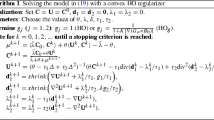Abstract
In this paper we propose a unified variational image editing model. It interprets image editing as a variational problem concerning the adaptive adjustments to the zero- and first-derivatives of the images which correspond to the color and gradient items. By varying the definition domain of each of the two items as well as applying diverse operators, the new model is capable of tackling a variety of image editing tasks. It achieves visually better seamless image cloning effects than existing approaches. It also induces a new and efficient solution to adjusting the color of an image interactively and locally. Other image editing tasks such as stylized processing, local illumination enhancement and image sharpening, can be accomplished within the unified variational framework. Experimental results verify the high flexibility and efficiency of the proposed model.
Similar content being viewed by others
References
Faugeras O, Luong Q, Maybank S. Camera self-calibration: Theory and experiments. In Proc. 2nd European Conference on Computer Vision, Santa Margherita Ligure, Italy, May, 1992, pp.321–334.
Hartley R, Zisserman A. Multiple View Geometry in Computer Vision. Cambridge University Press, 2000.
Hartley R. In defence of the 8-point algorithm. In Proc. 5th International Conference on Computer Vision, Massachusetts, USA, June 20–23, 1995, pp.1064–1070.
Zeller C, Faugeras O. Camera self-calibration from video sequences: The Kruppa equations revisited. Research Report 2793, INRIA, 1996.
Triggs B. Autocalibration and the absolute quadric. In Proc. IEEE Conference on Computer Vision and Pattern Recognition, Puerto Rico, USA, June 1997, pp.609–614.
Wu W T. Basic Principles of Mechanical Theorem Proving in Geometries. Volume I: Part of Elementary Geometries, Beijing: Science Press, 1984; Springer 1994.
Wu W T. Mathematics Mechanization. Science Press/Kluwer Academic, Beijing, 2000.
Sturm P. A case against Kruppa’s equations for camera self-calibration. In Proc. IEEE International Conference on Image Processing, Chicago, Illinois, October, 1998, pp.172–175.
Sturm P. A case against Kruppa’s equations for camera self-calibration. IEEE Trans. Pattern Analysis and Machine Intelligence, 2000, 22(10): 1199–1204.
Sturm P. Critical motion sequences for monocular self-calibration and uncalibrated Euclidean reconstruction. In IEEE International Conference on Computer Vision and Pattern Recognition, Puerto Rico, June, 1997, pp.1100–1105.
Pollefeys M, Koch R, Van Gool L. Self-calibration and metric reconstruction in spite of varying and unknown intrinsic camera parameters. In Proc. 6th International Conference on Computer Vision, Bombay, India, January 1998, pp.90–95.
Author information
Authors and Affiliations
Corresponding author
Additional information
A preliminary version of this paper appeared in Proc. Pacific Graphics 2005, Macau.
This work is partially supported by the National Basic Research 973 Program of China (Grant No. 2002CB312100), the National Natural Science Foundation of China (Grant No. 60403038), the National Natural Science Foundation of China for Innovative Research Groups (Grant No. 60021201).
Yun Zeng is now an M.S. candidate in State Key Lab of CAD&CG, Zhejiang University. He received his B.S. degree in 2004, Zhejiang University. His current research interests include theories and algorithms in computer vision and photo-realistic rendering in computer graphics.
Wei Chen is an associate professor in State Key Lab of CAD&CG at Zhejiang University, P.R. China. From June 2000 to June 2002, he was a joint Ph.D. candidate in Fraunhofer Institute for Graphics, Darmstadt, Germany and received his Ph.D. degree in July 2002. He has performed research in computer graphics and volume visualization. His current research interests include Bio-medical imaging and digital geometry processing, volume visualization and efficient modeling and photo-realistic rendering in virtual reality.
Qun-Sheng Peng is a professor of computer graphics at Zhejiang University. His research interests include realistic image synthesis, computer animation, scientific data visualization, virtual reality, bio-molecule modeling. Prof. Peng graduated from Beijing Mechanical College in 1970 and received his Ph.D. degree from the Department of Computing Studies, University of East Anglia in 1983. He serves currently as a member of the editorial boards of several international and Chinese journals.
Rights and permissions
About this article
Cite this article
Zeng, Y., Chen, W. & Peng, QS. A Novel Variational Image Model: Towards a Unified Approach to Image Editing. J Comput Sci Technol 21, 224–231 (2006). https://doi.org/10.1007/s11390-006-0224-4
Revised:
Issue Date:
DOI: https://doi.org/10.1007/s11390-006-0224-4



